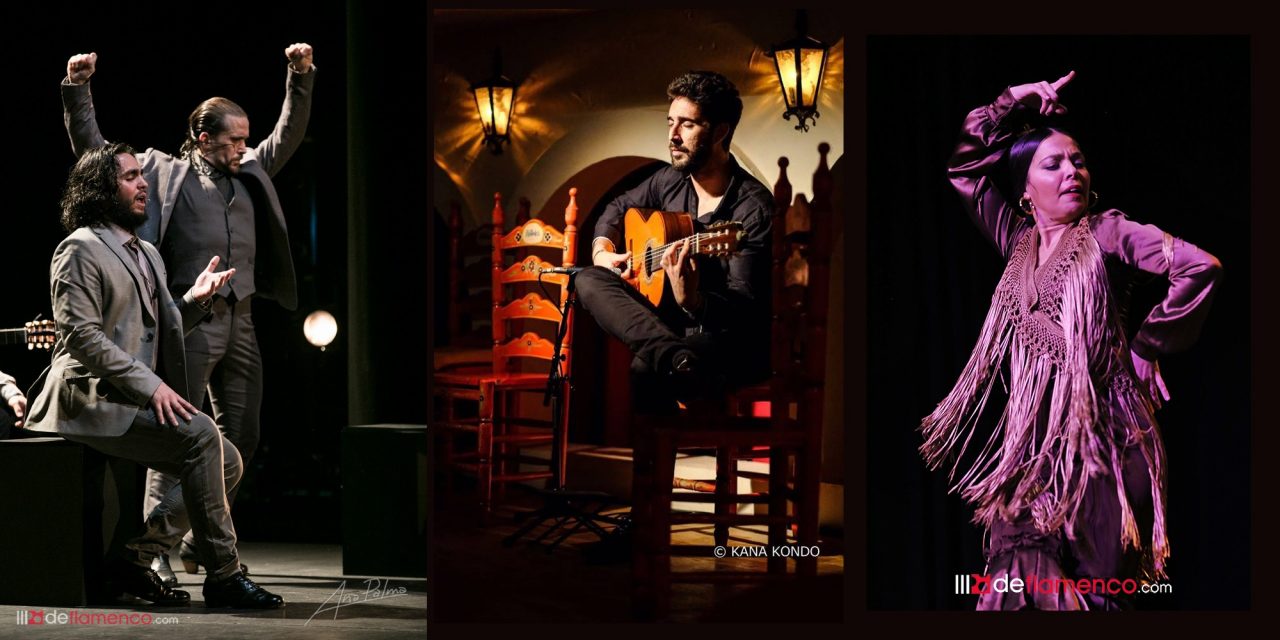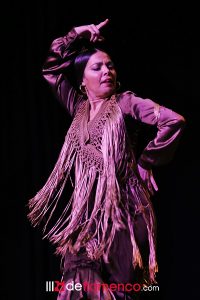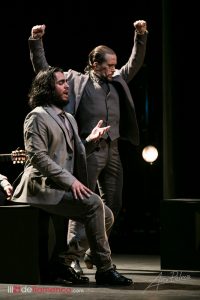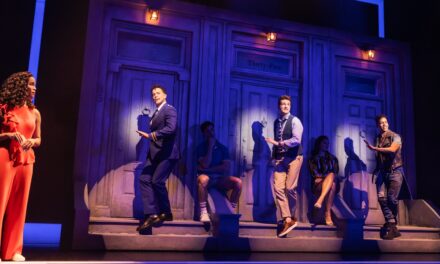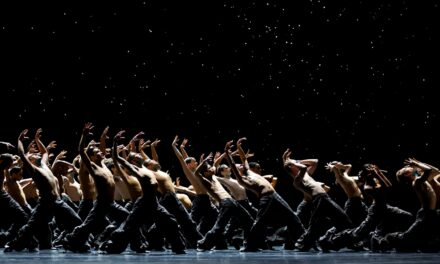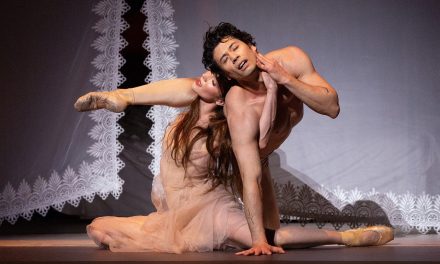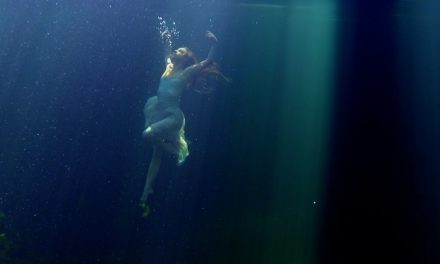The stage is dimly lit and blue, complemented by a rippled red curtain. The guitarist enters the stage, takes a seat in the shadows, and begins tuning his guitar. The dancers and musicians walk out one by one and there is an ominous and intentional distance between them. Vanesa Coloma‘s dress, bright like the color of red hots, is striking against the dim and hazy stage. She acknowledges the audience with a slight head nod. The dancers move slowly until instinct sparks small spurts of movement in their bodies. The space on stage seems quiet and solitary, except for the moments when Coloma’s charismatic and theatrical persona vanquish the silent haze. In complete confidence she intertwines her movement with Flamenco dichos and letras delivered in what in is reminiscent of slam poetry. Her presence is captivating and commands the attention and respect of the audience.
In a serene manner, Alfonso Losa demonstrates articulate and extraordinary technical ability. His presence and discerning gaze project beyond the back wall of the theatre, across the city skyline that surrounds the hill where the theatre stands. It feels as though something inside Losa takes over his entire being when he begins to dance. However, Losa cannot help his expression of joy as Coloma enthusiastically initiates a festive Bulerías to commence the show. Enthusiastically the dancers step out of their solitary movements and join together. It is refreshing to see a show that so openly displays the genuine camaraderie and spirit among the performers.
Moments before the show, I sit on a chair in a small dressing room as guitarist, Antonio Sánchez and singer, Ismael De La Rosa, also known as “El Bola”, walk in to join Losa and Coloma. Coloma is busy fashioning her hair in Flamenco style as she secures a large bun beneath three carnations nestled in her hair. Although still preparing, she is attentive and considerate to her compañeros and myself. The energy in the room is inviting and amiable. Their love for Flamenco is evident in the way that they passionately express their work and pride in collaborating with each other. They recount preparing for the show in cafes and studios in Madrid where they meet to share and try out new ideas. When asked about the motivation behind the show, Loso commented, “El show se llama prendidos, quiere decir que estamos prendidos, prendidos de este arte. Estamos todavía viviendo Flamenco, no solo como trabajo, pero forma de vida. Y estamos prendidos a un arte que nos enseña vivir, y seguramente nos vea morir. [“The show is called Prendidos, it means that we are ignited, attached to this art. We are still living Flamenco, not only as work, but as a way of life. And we are attached to an art that teaches us to live and will surely see us to die]”. For these skillful performers, Flamenco is more than performance, it is a way of life.
Prendidos Flamenco!, was brought to the Barnsdall Gallery Theatre by Vanesa Coloma and Alfonso Losa. Both dancers are extraordinarily talented and see Prendidos as an opportunity to showcase the wealth of history and influence that shapes Flamenco. The message carries through subtlety such in the beginning as when the performers are dancing to an old Flamenco recording and we catch a glimpse into not only what has shaped Flamenco, but what has shaped these artists. Coloma and Losa both began dancing as children in Madrid, a city rich with Flamenco history and culture. The two undoubtedly have a profound appreciation for Flamenco’s history, one rooted in tradition and family, as they bring Flamenco’s story to the stage in present day. In this particular performance audience members were lucky enough to also see Los Angeles based Flamenco artists including Manuel Gutierrez (bailaor), José Cortés Fernández (cantaor), Diego Álvarez (percussion), and Andrés Vadin (guitarist).
In between moments of festive dancing, the performers blessed us with intimate solo works including but not limited to a Farruca danced by Alfonso Losa, a Seguiriya danced by Manuel Gutierrez, and Soleá in bata de cola (Flamenco skirt with a train of ruffles) danced by Vanesa Coloma. Coloma’s Soleá was particularly striking as she captured the feeling in her body and bata. Soleá, which directly translates to loneliness, is danced at a slow tempo and typically complimented by cante jondo, or deep Flamenco singing. The image of Coloma surrounded by her bata and gripping the black ruffles close to her face in agony as if hanging on to life itself is still a vivid memory. At this moment we see another side of Coloma’s cheerful self. She emulates pain and suffering in her movement. Soleá is a beautiful and meaningful confrontation with pain. The piece left audience members moved as Coloma danced through her darkness on stage. Whether it was dancing a Soleá or laughing through a “fin de fiesta” (celebratory dance to end the show), these artists put their hearts on the stage, and it was without a doubt felt by the audience. The vulnerability of the performers allowed for an emotional journey for the audience from deep sadness to overwhelming feelings of joy. Prendidos was truly a visceral and expansive experience that will not be forgotten in our hearts.
If you are inspired to see more Flamenco performance please join Flamenco lovers all over California on June 7th at The Broad Stage in Santa Monica to see world renowned dancers Ádrian Santana and Águeda Saavedra perform the 10th festival of Cumbre Flamenca. There will be tickets available for a pre-show paella and tapas reception catered by Savory Roads catering (highly recommended).
Artists will be teaching master classes around the Los Angeles area. To reserve your space in a class and or to purchase tickets please click here.
Featured image: Alfonso Losa (dancing) in Jerez – Photo by Ana Palma; Antonio Sanchez – Photo by Kana Kondo; and Vanesa Coloma – Photo deflamenco.com.

